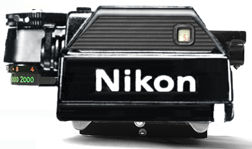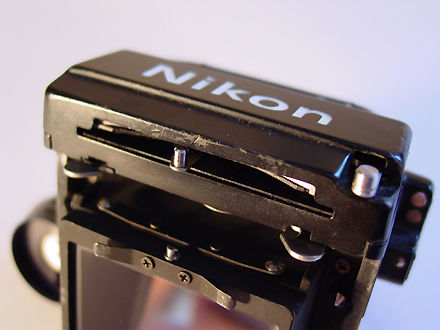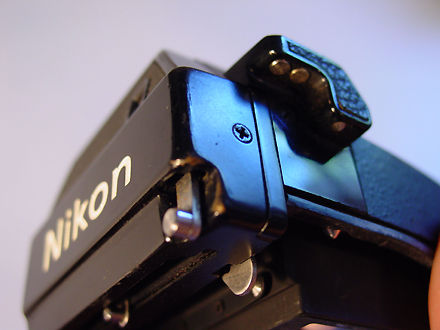The Silicon Photo Cells used in the metering circuitry provides a rapid response to changing light levels, and they are especially advantageous for accurate and quick readings under low-light conditions to EV-2. In most cases, it reacts more responsive than the Cds especially in rapid light changing conditions.
 |
Additional sophistication employed in the metering system include a monolithic IC for exposure detection and indication, and a metallic thin-film resistor (the Functional Resistance Element or FRE); both of these devices help to ensure the most dependable operation under demanding picture-talking situations. In addition, this finder couples with the EE Aperture Control Attachments DS-1, DS-2 for shutter-speed priority automatic exposure control. |
Other than the differing metering cells it used for light/exposure measurement; there are also a few improvement made to the DP-3. First is the exposure display; retaining the lighting-emitting diodes (LEDs) system which is far superior than match-needle system in low light photography with its bright and contrasty display characteristics; it was designed to be more friendly and easier to use. The system was in fact, adopted and used for exposure display inside the viewfinder of the immensely popular Nikon FM/FM2(n) which is still marketed today. The main difference could be just that the F2SB (and the F2AS) display those LED metering guides in horizontally axis instead of the FM series vertical arrangement.
Exposure settings with the DP-3 are easy to see, easy to set via the LEDs for visual display. The combination of the three LEDs within the finder enables five-step display of the exposure for fine adjustments to the precise setting desired.
 |
The DP-3 has three LED exposure indicators visible within the finder view field ("+" for overexposure, 'loll for correct exposure, and "-" for underexposure); thus, the DP-3 is capable of providing easy-to-read exposure information in five steps, and even at low-light levels. Additionally, the selected shutter speed and lens aperture settings are visible for maximum ease of operation. for setting the desired exposure. |
To determine the correct exposure with the DP-3: Switch ON the meter by moving the film-advance lever to the standoff position; with this action, one of the LED indicators will light, indicating overexposure, correct exposure or underexposure.
 |
 |
Credit: Image of this early non-Ai Nikon F2SB with DP3 metered prism coutesy of: Russell Gough® <rpg@daytonadvd.com>". Russell also has a EBAY STORE on his own. All images appeared herein are Copyright © 2003. All rights reserved. Please respect the visual property of the contributing photographer.
With all those non-AI lenses, the F2SB works like all those older F2 bodies/metered prisms discussed in earlier sections, in order to measure exposure at full aperture with lenses having different maximum apertures, the meter must be adjusted to the maximum aperture of the lens in use.
Since the metering is performed with the lens diaphragm fully open, the maximum aperture of a lens in use must be set into the meter. After mounting the lens, just turn the aperture ring counterclockwise, all the way to the minimum aperture setting, then clockwise as far as it will go. The aperture thus set will appear in the maximum aperture indicator window. This is done each time the lens is attached or changed as follows:
|
WARNING: Certain manual focus AI-S lenses such as Nikon Series E and ALL current version of AF Nikkor lenses WITHOUT the meter coupling Shoe (Rabbit EARs) on top of the aperture ring will not couple with the DP-1 Finder's exposure coupling.
The meter on/off switch is again controlled via the camera's film advance lever (the only switch atop the finder is to turn on the finder illumination and NOT for the metering). It is switched on by pulling out the lever to uncover a red dot on the top plate of the camera and switched off by pressing the lever flush against the camera body.
Viewfinder Accessories
The Photomic
finder DP-3 shares and accepts a host of Nikon designed viewfinder attachment accessories,
some are designed specifically for Nikon F2 bodies. Popular ones include Right-Angle
Viewing Attachment DR-3, Eyepiece Magnifier, Rubber Eyecup and a complete range of
Eyepiece Correction Lenses. Most of these general accessories can also be used with
the DP-3 without any significant compatibility problems.
 |
|
Among all the F2's non-AI metered prism, this unit is also the most collectible. A good condition F2SB is hard to come by and it took me quite a while to see one. It is an extremely well made viewfinder. The idea of using EE aperture Control Attachment Unit DS-1/DS-2 to convert the camera into a shutter priority auto exposure camera was excellent but as such a setup are real power hungry and the frequent recharging with short working duration make it far from perfect for practical use. But those days, that was a solution for those who demanded for such sophistication and amazingly, it delivers an answer those days.
I would always like to remind
you that the F2SB is still a non-AI body and naturally, its non-AI (automatic
maximum aperture indexing)
"status" has some limitation in areas of compatibility with modern Nikkor
lenses. Virtually all modern Nikkor do not provide the meter coupling shoe on the
aperture ring anymore. On question of whether it's worths to invest into a new unit
? Well, guess I have to ask you whether you think will the pool of collectors grows
and expands ? I guess so. But if you are thinking of getting a unit solely for day
to day operation, consider a practical alternative and often cheaper FM2(n) and leave
that to a collector who may has the patience of upkeeping and ensuring a continual
existence for such a classic SLR. If
you have a unit for sale, sell me...cheaper.
BEFORE skipping this page
to next section, please be reminded the Instruction Manual for DP-3 Finder in HTML
is also available in this site. Please don't
mail me
for any PDF version.
| Previous | Next | 9/17 Compatibility between AI, AI modified and AI-S lenses OR skip next page to DP-11 Metered Prism
| Back | Main Index Page - Interchangeable Viewfinders
System
Accessories:
Motor
Drives
/ Prisms / Screens / Macro / Film
Backs
/ Flash
Other Accessories:
DS-1 / DS-2 / DS-12 / eyepiece / DH-1 / cases / Cable releases / Miscellaneous
| History
& Background
| Semi-FAQ | Various Features and Functions - 6 Parts |
| Message Board | for
your favourite Nikon
F2 Series SLR model(s)
| Message Board | for your Nikon Optics in a shared environment
| Message Board | Specifically for Dispose or Looking for Nikon/Nikkor Photographic
Equipment
| Back | to Main Index Page of Nikon F2 Series SLR models
| Back |
Main Index Page of Pictorial History of Nikon SLRs
 |
The Eyes of Nikon:- |
Fisheye-Nikkor Lenses - Circular | Full Frame | Ultrawides Lenses - 13mm15mm18mm20mm | Wideangle Lenses - 24mm28mm35mm |
Standard Lenses - 45mm 50mm 58mm | Telephoto Lenses - 85mm105mm135mm180mm & 200mm |
Super-Telephoto Lenses - 300mm 400mm 500mm 600mm 800mm 1200mm |
Special Application lenses:
Micro-Nikkor Lenses - 50mm~55mm -60mm 85mm -105mm 200mm Micro-Zoom 70-180mm
Perspective Control (PC) - 28mm 35mm PC-Micro 85mm
Dedicated Lenses for Nikon F3AF: AF 80mm f/2.8 | AF 200mm f/3.5 EDIF
Depth of Field Control (DC): 105mm 135mm
Medical Nikkor: 120mm 200mm
Reflex-Nikkor Lenses - 500mm 1000mm 2000mm
Others: Noct Nikkor | OP-Nikkor | UV Nikkor 55mm 105mm | Focusing Units | Bellows-Nikkor 105mm 135mm
Nikon Series E Lenses: 28mm35mm50mm100mm135mm | E-Series Zoom lenses: 36~72mm75~150mm70~210mm
MF Zoom-Nikkor Lenses: 25~50mm | 28~45mm | 28~50mm | 28~85mm | 35~70mm | 36~72mm E | 35~85mm | 35~105mm | 35~135mm |
35~200mm | 43~86mm | 50~135mm | 50~300mm | 70~210mm E | 75~150mm E | 80~200mm | 85~250mm |
100~300mm | 180~600mm | 200~400mm | 200~600mm | 360~1200mm | 1200~1700mm
Tele-Converters: TC-1 | TC-2 | TC-200 | TC-201 | TC-300 | TC-301 | TC-14 | TC-14A | TC-14B | TC-14C | TC-14E | TC-16 | TC-16A | TC-20E
![]()
Nikon F
| Nikon F2 |
Nikon
F3
| Nikon F4 |
Nikon
F5
| Nikon F6 |
Nikkormat / Nikomat |
Nikon FM
| Nikon FE/ FA | Nikon EM/FG/FG20 | Nikon Digital SLRs | Nikon - Other models
MIR Supports for Photographic Community: Various Message Boards/Community
Forums
Nikon
F-series|
Nikon
F2-series|
Nikon
F3-series|
Nikon F4-series| Nikon
F5-series|Nikkormat/Nikomat-series
Nikon FM-series|Nikon
FE-series|Nikon
FA|Nikon
Digital
SLR
series|Various
Nikon
Models|Nikkor
Optic
-shared
Others:- Free Trade Zone - Photography| Free Trade Zone - Business Community |Free To Zouk - Photographic Community
Apple's Mac Public Community Message Board | Windows based PC &
Apple/Mac
Public Community Trade Exchange Centre
Recommended links to understand
more technical details related to the Nikkor F-mount and production Serial Number:
http://rick_oleson.tripod.com/index-153.html by: my friend, Rick Oleson
http://www.zi.ku.dk/personal/lhhansen/photo/fmount.htm by: Hansen, Lars Holst
http://www.mir.com.my/rb/photography/hardwares/nikonfmount/lens2.htm
http://www.photosynthesis.co.nz/nikon/serialno.html
About this photographic site.
HOME - Photography in Malaysia |
Copyright © 2000. leofoo ®. MIR Web Development Team.
In
memory of my friend Com.
Augusto Staut,
Brazil, 1971-2000.
Credit: Chuck Hester, US for his patience, encouragement
and help to setup the various content in this site; Robert Johnson for some of his original
images on the F2H-MD appeared in this site; my ex-staff, KiaSu for his superb
3-D logo appeared in this Nikon F2 site; Marc Vorgers from Holland who
generously provide me with some of his images of F2AS; MCLau®, who has so much time with me to
re-edit the content in this site and not to mention buying a Nikon Coolpix 990 just
for this site. Keat Photo,
Kuala Lumpur for providing
their Nikon F2A to take some images for this site; again, Mr Edward Ngoh the
great camera collector who provides us his collection of F2AS with MD-2; hawkeye.photographic.com
for their images on the Speed Magny film backs; Sean Cranor for his image
on Nikon F2 25th Anniversary Model; Ted Wengelaar®, Holland for his continuous
flow of input on some of the early Nikon bodies; CYLeow ® , photo editor of the Star
newspaper, Malaysia for some of his images used in this site. Ms Rissa Chan, Sales manager from
Shriro Malaysia who has helped to provide some of the very useful input. HiuraShinsaku®,
Nikomat ML, Japan for some of his images on various F2 models; my staff, Wati, Maisa, Mai and my nephew, EEWyn®, who volunteered and helping me
did so many of the film scanning works. Contributing photographers or resellers:
Jen Siow, Foo KokKin, Arthur Teng, Mark Fallander, John
Ishii, Ed Hassel, YoonKi Kim, Jean-Louis, M.Dugentas (Dell Corner.com.), Mr "Arsenall" and a few images mailed
in from surfers with no appropriate reference to their origin. Dedicated to KU Yeo, just to express our mutual regrets over the outcome of
a recent corporate event. Made with a PowerMac, broadcast with a Redhat Linux powered server.
![]()
![]()
